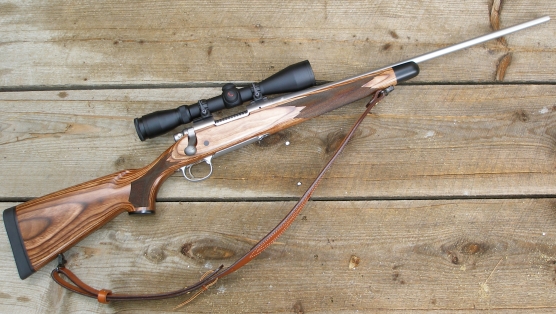
I work in a great setting; at the top of a mountain road, back in the middle of the woods, where I can actually own, shoot and enjoy firearms. In the distance I can hear heavy earth moving equipment at work, but I’m going to enjoy this freedom for as long as I can. Some change is good, some not so much. I do know that no one sings like Johnny Cash anymore, no one writes like Elmer Keith anymore and it’s been a long time since a “Sporting Goods” sign above the door of a shop meant they sell nothing more than firearms and fishing tackle. I say these things only to put the comments that follow into context.
I shoot a lot of firearms through the course of a year, which has led me to the assessment that I don’t like very many of the newer guns. Most are an exercise in “You’ve got to be kidding me”. They are too heavy, or overpowered, or too underpowered, or too expensive, or just too silly looking to be considered a serious hunting firearm outside of Massachusetts. The Remington Model 700 Mountain Rifle LSS is NOT one of these firearms. In fact, within a few minutes of handling the gun, I mounted a scope on it, headed for the woods with a pile of ammunition and stayed there for the rest of the day. Just a man, a rifle and a really good peanut butter and grape jelly sandwich on sourdough bread.
A little background…
 The Remington Mountain Rifle has been on the market for some time. First introduced as a walnut stocked and blued hardware gun in 1986, a stainless steel version was added in 1993. 1995 saw the addition of a detachable magazine variation and, in 1999, this laminated stock, stainless barreled action was added. Over time, beyond the major model designations, the Mountain Rifle has received numerous subtle enhancements to fit and finish.
The Remington Mountain Rifle has been on the market for some time. First introduced as a walnut stocked and blued hardware gun in 1986, a stainless steel version was added in 1993. 1995 saw the addition of a detachable magazine variation and, in 1999, this laminated stock, stainless barreled action was added. Over time, beyond the major model designations, the Mountain Rifle has received numerous subtle enhancements to fit and finish.
I own a detachable magazine model Mountain Rifle, chambered for the 25-06 Remington. It’s a great shooter, but a little short on barrel length for that cartridge’s case capacity and a little light in bullet weight; two reasons why I wanted to work with the same gun in 7mm-08 Remington. The 25-06 has a case capacity of approximately 66 grains, the 7mm-08 is approximately 55 grains, which should make it more efficient in a relatively short barrel gun. The typical heavy bullet weight for the 25-06 is 120 grains, whereas the 7mm-08 can easily pull along 140 grains with an upside potential of 160 grains.
Details, details, details…
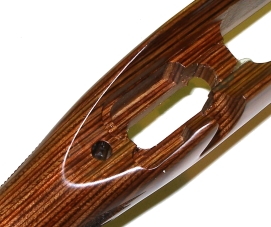 Remington has put real effort into improving the appearance and performance of their firearms. Beyond the exceptional out-of-the-box accuracy, stainless steel parts are cleanly machined and uniformly matte finished and the newest generation of laminated stocks look great. The laminate pressure treated birch layers are only about 0.060″ thick, which makes for greater strength and stability and more interesting patterns on contoured areas. The wood has slightly darker tones than earlier versions. The cut checkering is clean, sharp and contrasting, unlike earlier examples where the checkering was nearly invisible. I know these are a finesse touches, but they add up to a much better looking gun.
Remington has put real effort into improving the appearance and performance of their firearms. Beyond the exceptional out-of-the-box accuracy, stainless steel parts are cleanly machined and uniformly matte finished and the newest generation of laminated stocks look great. The laminate pressure treated birch layers are only about 0.060″ thick, which makes for greater strength and stability and more interesting patterns on contoured areas. The wood has slightly darker tones than earlier versions. The cut checkering is clean, sharp and contrasting, unlike earlier examples where the checkering was nearly invisible. I know these are a finesse touches, but they add up to a much better looking gun.
Inletting is very precise. Clamped surfaces are uniform and closely support the gun’s action and recoil lug. The Mountain Rifle’s barrel is floated then supported at two pressure points 2 ” in from the tip of the forearm. The barrel runs right down the center of the channel with a uniform gap on both sides. The R3 recoil pad is super resilient and shock absorbing without being mushy, and it doesn’t grab at clothing when the gun is pulled to the shoulder. The center of gravity, with a scope in place, is approximately 1 ½” back from the front floorplate screw, so most of the weight is carried at the shoulder and not the hand extended under the forearm. Still, there is enough weight out front to make the gun easy to hold steady. The stock is straight cut, like many American firearms, with a uniform 1 ⅛” drop at the comb and heel. The stock provides a very natural point and eye – scope alignment is comfortable.
| Quick Reference | |
| Overall Length | 41 ½” |
| Pull | 13 ⅜” |
| Barrel Length | 22″ |
| Twist Rate | 9 ¼” |
| Weight | 6 ¾ Lbs |
| Trigger pull | 5 lbs 4 oz +/- 2 oz |
| Chamber | 7mm-08 Remington |
| Mag Capacity | 4 Rounds |
| Max Cartridge Length | 2.830″ (+0.030) |
The LSS is light, compact and fast handling. The barrel tapers from 1.190″ at the receiver to 0.750″ over the next 4″. The recessed target crowned muzzle is 0.547″ in diameter. Employing a slender 22″ barrel was a smart move on Remington’s part as it yielded a gun that weighs the same as the little Model Seven with its 20″ barrel. The Mountain Rifle’s short action adds a minimum amount of mass while providing maximum rigidity. The action is long enough to accommodate rounds as long as 2.950″, however, the magazine well and feed ramp limit cartridge length to just over the 2.800″ SAAMI spec for the cartridge. All factory ammunition and reasonable handloads cleared the magazine and ejection port and cycled without a problem.
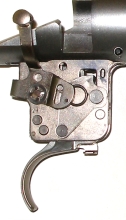 The X-Mark Pro trigger is not owner adjustable, unless the owner works at a factory authorized repair center. Before jumping in with a crowbar, pliers and a wheel puller, I would caution that the adjustment procedure differs from earlier Remington triggers and following the early trigger adjustment sequence could result in damage to the new trigger. I don’t know why, in the midst of an industry trend toward single set and highly adjustable triggers, Remington elected to move in this direction, but they did, and the resulting fallout may be more emotional reaction than reaction to a real problem. The pull on the example I shot is 5¼ lbs, or about 1¼ lbs more than I typically set my triggers. Accuracy didn’t suffer, I didn’t notice the difference after shooting a dozen rounds or so and it is probably safer as a hunting trigger. What I lost was my right to adjust the trigger down to 4 lbs then, realizing it is too light for a safe hunting rifle, crank it back up to 5¼ lbs. The X-Mark Pro trigger is a nicely finished piece of manufacturing technology; smooth with no creep. The safety is a simple two position piece, which works just fine for me. I can never remember what the third position does, anyway.
The X-Mark Pro trigger is not owner adjustable, unless the owner works at a factory authorized repair center. Before jumping in with a crowbar, pliers and a wheel puller, I would caution that the adjustment procedure differs from earlier Remington triggers and following the early trigger adjustment sequence could result in damage to the new trigger. I don’t know why, in the midst of an industry trend toward single set and highly adjustable triggers, Remington elected to move in this direction, but they did, and the resulting fallout may be more emotional reaction than reaction to a real problem. The pull on the example I shot is 5¼ lbs, or about 1¼ lbs more than I typically set my triggers. Accuracy didn’t suffer, I didn’t notice the difference after shooting a dozen rounds or so and it is probably safer as a hunting trigger. What I lost was my right to adjust the trigger down to 4 lbs then, realizing it is too light for a safe hunting rifle, crank it back up to 5¼ lbs. The X-Mark Pro trigger is a nicely finished piece of manufacturing technology; smooth with no creep. The safety is a simple two position piece, which works just fine for me. I can never remember what the third position does, anyway.
I just spent 30 seconds trying, unsuccessfully, to delete a semicolon… that turned out to be very small ant parked on my computer screen. What does he think this is, The Discovery Channel? I really need to get my eyeglass prescription checked, or move some place where there are larger ants. He is probably in search of PB&J debris. Anyway –
 The Remington’s hinged floorplate and trigger guard are a one piece aluminum casting. The external finish is excellent, however, there are parting lines on the sides of the assembly that are a bit unsightly. Yes, I am being really picky. The spring and follower, as well as the magazine box, are plated steel. The fasteners are stainless hex head, which all but puts an end to chewed up cross slots caused by over-ambitious hands and undersize screwdrivers…not that it has ever happened to me. The floorplate release is top and inside the trigger guard, the bolt release is just behind and to the side of the trigger. Some folks might tell you it is possible to put on heavy gloves and cause your gun to dump ammo and the bolt at the same time. I like to think of the location of these controls as convenient and I’ve been hunting long enough to appear in cave painting. I am aware of exactly ten people in the world who could have problems these controls. They share a small car and tend to frequent the circus.
The Remington’s hinged floorplate and trigger guard are a one piece aluminum casting. The external finish is excellent, however, there are parting lines on the sides of the assembly that are a bit unsightly. Yes, I am being really picky. The spring and follower, as well as the magazine box, are plated steel. The fasteners are stainless hex head, which all but puts an end to chewed up cross slots caused by over-ambitious hands and undersize screwdrivers…not that it has ever happened to me. The floorplate release is top and inside the trigger guard, the bolt release is just behind and to the side of the trigger. Some folks might tell you it is possible to put on heavy gloves and cause your gun to dump ammo and the bolt at the same time. I like to think of the location of these controls as convenient and I’ve been hunting long enough to appear in cave painting. I am aware of exactly ten people in the world who could have problems these controls. They share a small car and tend to frequent the circus.
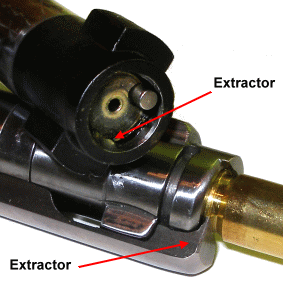 The Remington bolt, top, is push feed where a spring-loaded extractor closes over a cartridge rim when the bolt is pushed home. The Mauser bolt, lower in photo, is controlled feed, where the cartridge rim slips under the claw extractor as it is stripped from the magazine. I’ve had no problems with either system, however, Remington’s approach means the cartridge case head is completely enclosed when the bolt is driven home. I know, “three rings of steel” which sounds like the title of a Kung Fu movie, but also happens to be true. Model 700 rifles afford the shooter a good deal of protection.
The Remington bolt, top, is push feed where a spring-loaded extractor closes over a cartridge rim when the bolt is pushed home. The Mauser bolt, lower in photo, is controlled feed, where the cartridge rim slips under the claw extractor as it is stripped from the magazine. I’ve had no problems with either system, however, Remington’s approach means the cartridge case head is completely enclosed when the bolt is driven home. I know, “three rings of steel” which sounds like the title of a Kung Fu movie, but also happens to be true. Model 700 rifles afford the shooter a good deal of protection.
I’d guess, if more than Remington’s notion of an extractor is needed to pull a case out of a gun’s chamber, something else more pressing is wrong, like handloads generating excessive pressure or an owner in need of a good chamber brush.
Remington actions, unlike the classic Mauser action, feels slick, sort of like slip sliding on bearings. The polished bore in the Remington receiver that supports bolt travels measures 0.700″ while the bolt body’s diameter is 0.697″. The action’s lug tracks are 1.005″ across, while the lugs measure 1.000″. This fit is just close enough to provide lots of support, while not so tight as to cause binding at the first sign of dust. By comparison, a typical Mauser bolt body/receiver bore measures 0.702″ and 0.707″ respectively, for 0.005″ clearance. However, dimensions required to accommodate the large claw extractor that traverses the bolt are 1.000″ for the bolt and 1.053″ at the lug slots in the receiver, a whopping 0.053″ of mechanical slop. This additional clearance allows for a good deal of longitudinal deflection and side loading that often makes a Mauser bolt feel as though it is dragging or hanging. I am not condemning Mauser actions, I use them all of the time. It’s just nice to operate something that feels like more precise machinery.
Nitrex Optics, appropriate for the application…
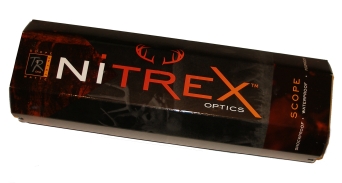 It seemed only fair to source a scope that was as nicely designed and manufactured as the rifle, but I didn’t want to spend a $1,000 or install a scope that would overpowered the cartridge or the rifle. Nitrex Optics is part of the ATK family, the same folks who make Federal Premium® products. The company has been pretty aggressive in pricing and promoting their Japanese manufactured Nitrex scope line, so I thought this would be a good place to jump in. I wasn’t disappointed.
It seemed only fair to source a scope that was as nicely designed and manufactured as the rifle, but I didn’t want to spend a $1,000 or install a scope that would overpowered the cartridge or the rifle. Nitrex Optics is part of the ATK family, the same folks who make Federal Premium® products. The company has been pretty aggressive in pricing and promoting their Japanese manufactured Nitrex scope line, so I thought this would be a good place to jump in. I wasn’t disappointed.
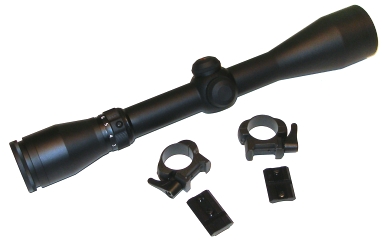 Nitrex scopes are shock, water and fog proof. The tubes are one piece aluminum construction and the optics are coated to cut glare, flare and provide excellent image clarity and contrast. The warranty is limited lifetime; parts and labor. Within the first year of purchase, the scope can be exchanged at any Nitrex retailer if defective. Again, the scope is manufactured in Japan, not designed there then assembled in Tahiti by college students on Spring Break. The price is $299 at online retailers.
Nitrex scopes are shock, water and fog proof. The tubes are one piece aluminum construction and the optics are coated to cut glare, flare and provide excellent image clarity and contrast. The warranty is limited lifetime; parts and labor. Within the first year of purchase, the scope can be exchanged at any Nitrex retailer if defective. Again, the scope is manufactured in Japan, not designed there then assembled in Tahiti by college students on Spring Break. The price is $299 at online retailers.
A 3-9x42mm scope with Weaver Top Mounts and Grand Slam steel rings with Lever Lok quick release system seemed good choices. The scope and hardware selected are matte black rather than silver, because I see no reason to make an aluminum scope look like stainless steel when the general objective is to not stand out like a human reflector when hunting. Someone was really awake when they did the aesthetics design on this scope. Very clean lines and brand identification marks, plus the scope is really matte black and not sort of half shinny semi gloss.
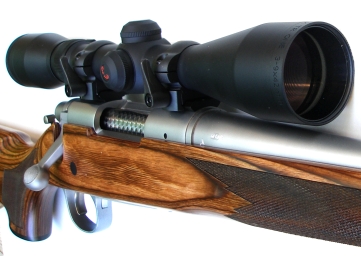 In more objective terms, the Nitrex 3-9x42mm scope is 12 ½” long when the ocular lens is compressed. The 42mm object lens’ bell is 1 ⅞” in diameter, the cushioned eye piece is 1 ⅛” in diameter. Although the Weaver rings are medium height and noted for use with up to a 40mm objective lens, there is sufficient clearance for this 42mm scope the clear the barrel without the appearance of being on stilts. 100 yard FOV is 35′ at 3x magnification, 12′ at 9x. Eye relief is a generous 3 ½”. Scope and rings brought the gun’s total weight to 8 lbs, or 20 ounces for scope mount system.
In more objective terms, the Nitrex 3-9x42mm scope is 12 ½” long when the ocular lens is compressed. The 42mm object lens’ bell is 1 ⅞” in diameter, the cushioned eye piece is 1 ⅛” in diameter. Although the Weaver rings are medium height and noted for use with up to a 40mm objective lens, there is sufficient clearance for this 42mm scope the clear the barrel without the appearance of being on stilts. 100 yard FOV is 35′ at 3x magnification, 12′ at 9x. Eye relief is a generous 3 ½”. Scope and rings brought the gun’s total weight to 8 lbs, or 20 ounces for scope mount system.
In use, I mounted the scope, sighted in with a laser bore sight and I was within half an inch of bullseye at 100 yards. Adjustments are ¼ MOA positive clicks with predictable results. index marks are sharp and contrasting in color to make them easy to see. Magnification and eyepiece diopter adjustments are quick twist and they stay put. I removed the scope from the rifle a dozen times or so to clean or photograph parts of the gun. The setup always held zero when reinstalled. There is a reflective lens retainer ring inside the objective bell that I would automatically label as a source of flair in bright sunlight. Interesting theory on my part, but quickly disproved, which may speak to the quality of the lens coatings. The image was always crisp and clear regardless the lighting conditions. Nitrex labels their reticle TrexPlex™ which means fast tracking medium thickness cross hairs from the outside to 80% toward the center. The central 20% is a thin crosshair that won’t obstruct a target. The only suggestion I could make to improve the product would be to include a set of lens caps.
And with a scope on the gun – few surprises…
Editor’s note – Because of the uncharacteristically low performance recorded for Hornady and Federal Fusion ammo, I reshot this portion of the project substituting an Oehler Model 43 three screen Chronograph for the Shooting Chrony that was utilized in the original data collection effort. Performance fell into line more closer to expectations. While Hornady Light Magnum ammo did not show performance significantly higher than other brands of ammunition, it did come in slightly better than initially recorded. Federal Fusion’s recorded performance was much better and closer to how this ammo typically performs.
 The handloading part of this project, Part II, includes a good selection of bullet weights and levels of performance. However, to properly assess firearm and factory ammunition I thought it would be best to select the most popular bullet weight for the 7mm-08 Remington, 140 grain. All data was recorded with the chronograph uniformly ten feet from the rifle’s muzzle, all actual data is an average of ten shots. I anticipated somewhat lower than advertised velocity readings as most all advertised velocity is based on a 24″ barrel, but I believe some variance to advertised performance is beyond barrel length consideration.
The handloading part of this project, Part II, includes a good selection of bullet weights and levels of performance. However, to properly assess firearm and factory ammunition I thought it would be best to select the most popular bullet weight for the 7mm-08 Remington, 140 grain. All data was recorded with the chronograph uniformly ten feet from the rifle’s muzzle, all actual data is an average of ten shots. I anticipated somewhat lower than advertised velocity readings as most all advertised velocity is based on a 24″ barrel, but I believe some variance to advertised performance is beyond barrel length consideration.
| Manufacturer | $ Box |
Bullet Weight |
Advertised FPS |
Actual FPS |
Variance FPS |
Velocity Ranking | 100 Yd Group |
| Federal Fusion | 28 | 140 | 2,850 | 2,798 | -52 | 4 | 1.5″ |
| Hornady Lgt Magnum | 29 | 139 | 3,000 | 2,830 | -170 | 2 | 0.9″ |
| Prvi Partizan | 16 | 140 | 2,854 | 2,794 | -60 | 5 | 1.2″ |
| Remington Core-Lokt | 25 | 140 | 2,860 | 2,872 | +12 | 1 | 1.1″ |
| Remington AccuTip | 34 | 140 | 2,860 | 2,810 | -50 | 3 | 0.7 |
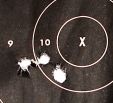
Hornady is typically conservative with posted ballistics and I can usually get close to those levels even with a slightly shorter barrel. In this case, the burn space needed to get the benefit of the light magnum ammo may have been the 2″ that were missing on the Mountain Rifle. The best of the bunch was Remington, not only in grabbing the number one spot for velocity, but also for delivering the best accuracy of all brands tested. Everything listed here is actually pretty good.
General Impressions…
The Mountain rifle was an easy gun to shoot. Recoil was insignificant, muzzle blast was sharp, but not excessive. The thin barrel heated up quickly approximately 10″ forward of the receiver. Checking with a Fluke infrared thermometer as shooting progressed, suggested cooling down after a half dozen rounds or so would be a good idea. With an ambient of 68°F, when the barrel shank hit 75°F the section 10″ forward was typically 90°F and the muzzle would eventually heat to 80°F. For a quickly as temperature rose, leaving the bolt open, with a slight breeze blowing, the barrel cooled down in fifteen minutes or so. I don’t see this as even close to a problem for a hunting rifle. I have a 338-378 Weatherby I could brand cattle with after half a dozen rounds, but hunting rifles don’t see frequent discharge.
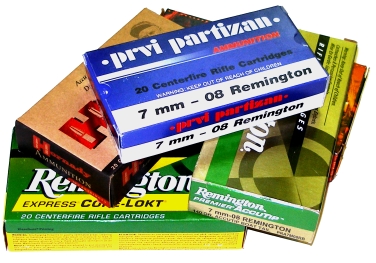 I thought the gun did really well shooting three shot groups and any of the factory ammo would have been perfectly acceptable for hunting anything in North America with the exception of big bear. This statement, of course, does not apply to Inuits who don’t read gun rags and would probably feel over- gunned hunting polar bear with the 7mm-08 Remington. I spoke with all ammo manufacturers regarding hunting applications with this round and, more specifically, these bullets. All indicated that hunting elk and moose with these rounds would be perfectly acceptable.
I thought the gun did really well shooting three shot groups and any of the factory ammo would have been perfectly acceptable for hunting anything in North America with the exception of big bear. This statement, of course, does not apply to Inuits who don’t read gun rags and would probably feel over- gunned hunting polar bear with the 7mm-08 Remington. I spoke with all ammo manufacturers regarding hunting applications with this round and, more specifically, these bullets. All indicated that hunting elk and moose with these rounds would be perfectly acceptable.
Performance expectations….
Running the Remington AccuTip’s performance through the Real Guns Ballistic Calculator and selecting a 3″ kill zone yielded the following:
| Best Zero Results | |||
| Near-Zero – yds. | 34 | Midrange – yds. | 113 |
| Far-Zero – yds. | 190 | Max Ordinate – in. | +1.5 |
| Point-Blank – yds. | 221 | ||
| Indices | Range | ||||||
| Range – yds. | 0 | 50 | 100 | 150 | 200 | 250 | 300 |
| Velocity – ft./sec. | 2872 | 2777 | 2685 | 2594 | 2505 | 2418 | 2332 |
| Energy – ft.-lbs. | 2564 | 2398 | 2240 | 2091 | 1950 | 1817 | 1691 |
| Path – in. | -1.5 | 0.5 | 1.4 | 1.2 | -0.4 | -3.4 | -7.8 |
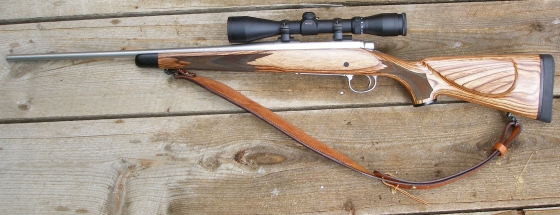
What we have here is a great little 300 yard rifle that is easy and inexpensive to shoot, that won’t wear a hunter down while crawling around in the brush or walking rough terrain, and it will hang nicely over a shoulder when dragging a nice buck out of the woods. I think there is a lot more in this combination and we’ll see if we can pull some of it out in the next and final installment of this project.
Related 7mm-08 Remington information on RealGuns.Com:
Remington’s Model 700 Mountain Rifle LSS
Handloading the 7mm-08 Remington – Hey, it’s not that slow!
7mm-08 Remington Handload Data

Email Notification